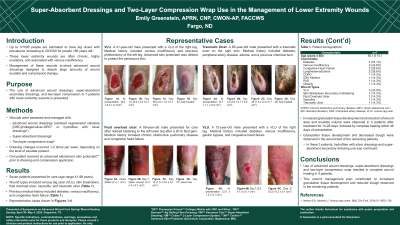Case Series/Study
(CS-057) Super-absorbent Dressings and Two-layer Compression Wrap Use in the Management of Lower Extremity Wounds
Friday, May 2, 2025
7:45 PM - 8:45 PM East Coast USA Time

Introduction: Up to 3/1000 people are estimated to have leg ulcers with prevalence increasing to 20/1000 for people >80 years old.1 These lower extremity wounds are often chronic, highly exudative, and associated with venous insufficiency. Management of these wounds involves advanced wound dressings designed to absorb large amounts of wound exudate and compression therapy. The use of advanced wound dressings, super-absorbent secondary dressings, and two-layer compression in 7 patients with lower extremity wounds is presented.
Methods: Wounds were assessed and managed with advanced wound dressings (oxidized regenerated cellulose [ORC]/collagen/silver-ORC* or hydrofiber with silver dressings†) along with super-absorbent dressings‡ and two-layer compression wrap§. Dressing changes occurred 1-2 per week, depending on the level of exudate present. One patient received an advanced elastomeric skin protectant** prior to dressing and compression application.
Results: Seven patients presented for care (age range 41-88 years). Wound types included skin breakdown secondary to skin blistering from lymphedema (n=1), fluid overload ulcer (n=1), venous leg ulcers (VLUs, n=3), vasculitis (n=1), and traumatic ulcer (n=1). Previous medical history included VLU, lymphedema, obesity, diabetes, vascular insufficiency, and endovenous ablation. In all 4 patients, increased granulation tissue development along with reduction of wound area and exudate volume was observed after treatment for 14-28 days. Complete wound healing was noted in 4 patients within 46 days of presentation. Granulation tissue development and decreased slough were observed in the wound bed of the remaining patients. Hydrofiber with silver dressing and super-absorbent dressing use was continued.
Discussion: Use of advanced wound dressings, super-absorbent dressing, and two-layer compression wrap resulted in complete wound healing in 4 patients. This wound management plan contributed to increased granulation tissue development and reduced slough observed in the remaining patients.
Methods: Wounds were assessed and managed with advanced wound dressings (oxidized regenerated cellulose [ORC]/collagen/silver-ORC* or hydrofiber with silver dressings†) along with super-absorbent dressings‡ and two-layer compression wrap§. Dressing changes occurred 1-2 per week, depending on the level of exudate present. One patient received an advanced elastomeric skin protectant** prior to dressing and compression application.
Results: Seven patients presented for care (age range 41-88 years). Wound types included skin breakdown secondary to skin blistering from lymphedema (n=1), fluid overload ulcer (n=1), venous leg ulcers (VLUs, n=3), vasculitis (n=1), and traumatic ulcer (n=1). Previous medical history included VLU, lymphedema, obesity, diabetes, vascular insufficiency, and endovenous ablation. In all 4 patients, increased granulation tissue development along with reduction of wound area and exudate volume was observed after treatment for 14-28 days. Complete wound healing was noted in 4 patients within 46 days of presentation. Granulation tissue development and decreased slough were observed in the wound bed of the remaining patients. Hydrofiber with silver dressing and super-absorbent dressing use was continued.
Discussion: Use of advanced wound dressings, super-absorbent dressing, and two-layer compression wrap resulted in complete wound healing in 4 patients. This wound management plan contributed to increased granulation tissue development and reduced slough observed in the remaining patients.

.jpg)
